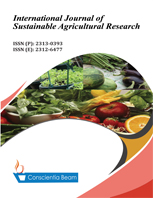Breeding Objective, Breeding Practices and Selection Criteria of Indigenous Sheep in Western Amhara, Ethiopia
DOI:
https://doi.org/10.18488/journal.70.2019.64.172.182Abstract
The purpose of this research was to generate organized information on breeding objectives, breeding practices and choice criteria of farmers in Farta, Lay Gayint and Sekela districts. A sum of 180 households was selected to survey questionnaires in selected districts, Semi structured questioner and group discussions were used as information sources. The average separation of the Statistical Analysis System was used to analyze the flock size and structure in the three districts. An index was calculated to supply an overall ranking of categorical variables. The average flock per house holding the study districts was 8.8±0.05 heads. For source of income (0.45), home use (0.28), saving (0.20), and manure (0.04) were the reasons of sheep keeping. The uncontrolled mating system was practiced by most (72.6 %) of households. In the study districts 37.7 % of farmers received their own breeding rams while the rest farmers shared with their neighbors. Appearance (0.38), growth rate (0.34), color (0.13), pedigree (0.10) and tail type and size (0.10) were the sheep owner’s standards for breeding ram, while the appearance (0.29), coat color (0.18), lamb growth (0.17), lambing interval (0.12), age at first lambing (0.09) and lamb survival (0.08) where the farmers' selection criteria for breeding ewes. Going through a breed improvement program considering the farmers’ production objectives and existing breeding practices is important. Nevertheless, designing alternative breeding strategies to key out the optimal number of traits to be considered and size of flocks to be mixed is crucial before setting up a breeding plan.

